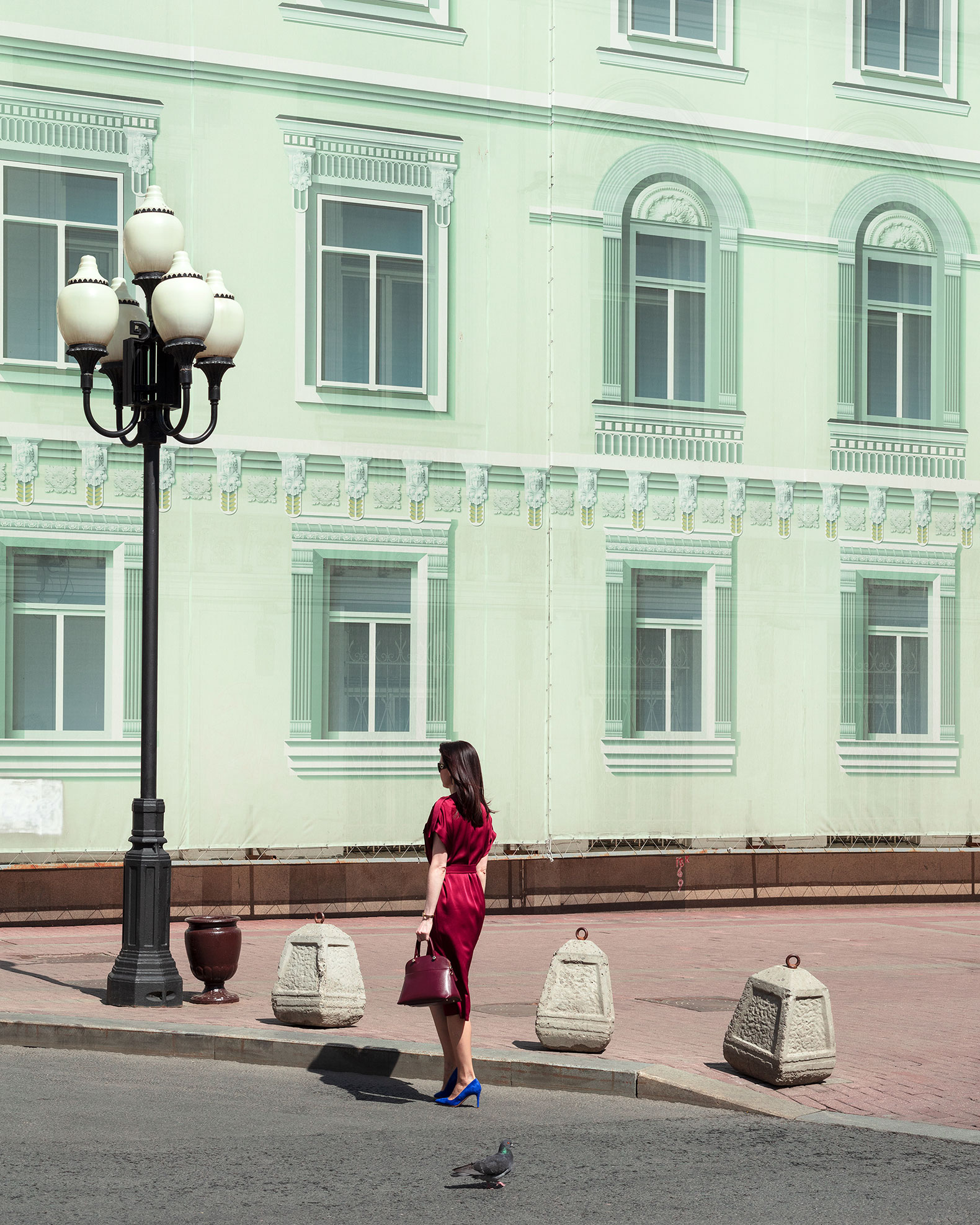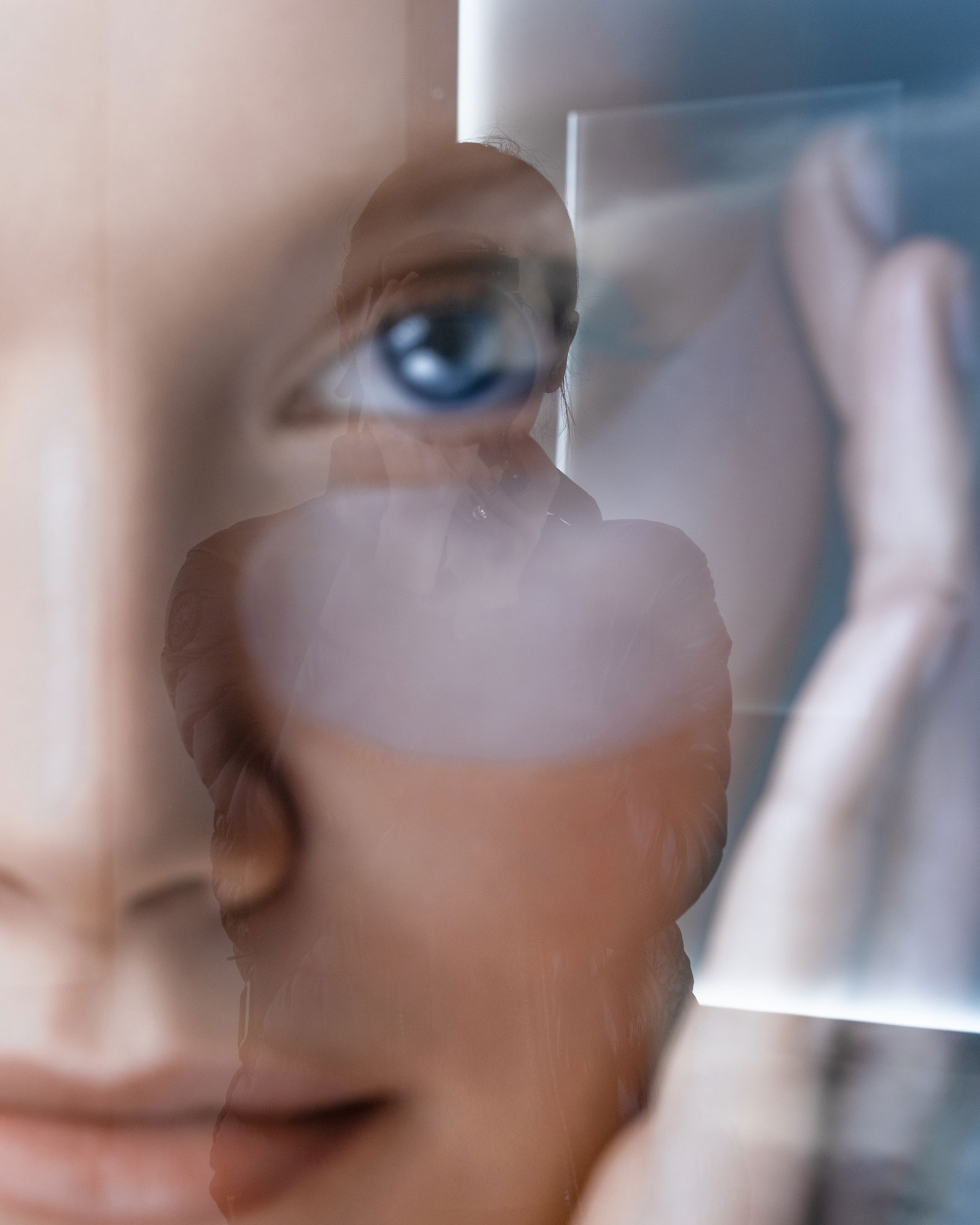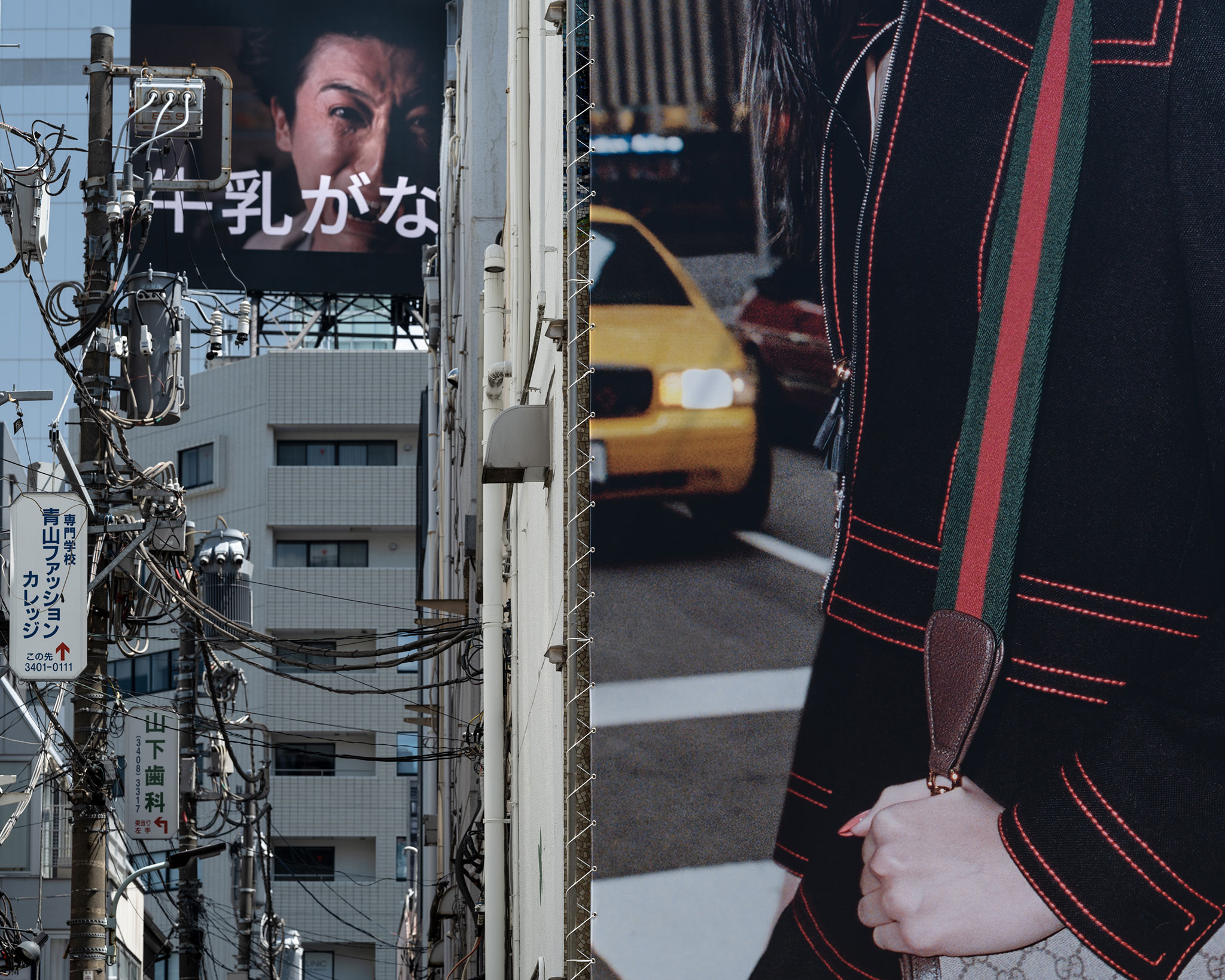"Images Cities" takes a tour of of fifteen different cities around the world, which began with the cities of Moscow and New York, and has subsequently been completed with Amsterdam, Paris, London, Brussels, Tokyo, Madrid or Barcelona.
The exhibition highlights the disappearance of individuality in the face of serialization and the indifference of passers-by in the face of the overexposure of advertising images showing lifestyles, luxury housing developments or technology, jewelry, perfume and fashion advertisements, "hyperphotogenic", collages of bright colors and clear contours, presenting games of reflections or compositions in succession of planes, in which the monumentality of the underlying architecture stands out.

"Arbat", Moscow, 2021, by Anastasia Samoylova. Exhibition “Image Cities”, KBr Fundación MAPFRE.
Samoylova's work is influenced by great figures of the documentary tradition such as Eugène Atget at the beginning of the 20th century, or especially relevant figures such as Berenice Abbot or Lisette Model. Samoylova's use of reflection games or compositions based on sectioned elements in her shots remind us of the work of Lee Friedlander, one of Samoylova's most revered artists, along with the work of Diane Arbus and Garry Winogrand from the late 1980s. sixties of the last century.
The last group of photographs is dedicated to the image of women in the city. The female figure is the center of consumer society, object and subject of advertising that links it to the existence of luxury and glamour. Something that has nothing to do with the problems and concerns of citizens.

"Beauty Advertisement", Vienna, 2022, by Anastasia Samoylova. Exhibition “Image Cities”, KBr Fundación MAPFRE.
The non-city.
Current economic context, of neoliberal economies, interconnected financial markets, global images, international economic and cultural centers show an increasingly similar urban context. On the other hand, cities like New York, Paris, London or Moscow try to promote difference, their own individuality that endows them with the specific history of each one of them. However, all cities are on their way to a generic urban landscape. An architecture unified by its materials, homes or offices practically the same. This project analyzes the role of photography in revealing this ideological gap between a demanding urban identity and the homogeneous reality that its images show.

"Graffiti", Barcelona, 2022, by Anastasia Samoylova. Exhibition “Image Cities”, KBr Fundación MAPFRE.
The collage.
Composition of her images is a factor of great interest to Samoylova. Through the style of these and the overlapping elements of her, she manages to obtain the results she is looking for. In these -visual collages-, which she begins with the Landscape Sublime series, the influence of work carried out by different Russian artists of the historical avant-garde, such as Natalia Goncharova or Liubov Popova. Her collage is generally made through royalty-free images taken from the internet. She prints, cuts, assembles, assembles and takes to the three-dimensional to return to the two-dimensional once photographed, in a work process that favors the manual and artisanal. In Image Cities, this resource becomes evident through the composition of the image.

"Art Poster (Warhol)", Los Angeles, 2022, by Anastasia Samoylova. Exhibition “Image Cities”, KBr Fundación MAPFRE.
The flâneur.
Some specialists point out that Samoylova would embody the female figure equivalent to the male flâneur, Charles Baudelaire's stroller. In this sense, the artist would become a contemporary flâneuse who travels through the city of the 21st century showing its less recognizable side and questioning the role of the image, and especially the use that it makes of the figure of the woman, in the global society.

"Luxury Fashion Advertisement", Tokyo, 2022, by Anastasia Samoylova. Exhibition “Image Cities”, KBr Fundación MAPFRE.
The exhibition highlights the disappearance of individuality in the face of serialization and the indifference of passers-by in the face of the overexposure of advertising images showing lifestyles, luxury housing developments or technology, jewelry, perfume and fashion advertisements, "hyperphotogenic", collages of bright colors and clear contours, presenting games of reflections or compositions in succession of planes, in which the monumentality of the underlying architecture stands out.

"Arbat", Moscow, 2021, by Anastasia Samoylova. Exhibition “Image Cities”, KBr Fundación MAPFRE.
Samoylova's work is influenced by great figures of the documentary tradition such as Eugène Atget at the beginning of the 20th century, or especially relevant figures such as Berenice Abbot or Lisette Model. Samoylova's use of reflection games or compositions based on sectioned elements in her shots remind us of the work of Lee Friedlander, one of Samoylova's most revered artists, along with the work of Diane Arbus and Garry Winogrand from the late 1980s. sixties of the last century.
The last group of photographs is dedicated to the image of women in the city. The female figure is the center of consumer society, object and subject of advertising that links it to the existence of luxury and glamour. Something that has nothing to do with the problems and concerns of citizens.

"Beauty Advertisement", Vienna, 2022, by Anastasia Samoylova. Exhibition “Image Cities”, KBr Fundación MAPFRE.
The non-city.
Current economic context, of neoliberal economies, interconnected financial markets, global images, international economic and cultural centers show an increasingly similar urban context. On the other hand, cities like New York, Paris, London or Moscow try to promote difference, their own individuality that endows them with the specific history of each one of them. However, all cities are on their way to a generic urban landscape. An architecture unified by its materials, homes or offices practically the same. This project analyzes the role of photography in revealing this ideological gap between a demanding urban identity and the homogeneous reality that its images show.

"Graffiti", Barcelona, 2022, by Anastasia Samoylova. Exhibition “Image Cities”, KBr Fundación MAPFRE.
The collage.
Composition of her images is a factor of great interest to Samoylova. Through the style of these and the overlapping elements of her, she manages to obtain the results she is looking for. In these -visual collages-, which she begins with the Landscape Sublime series, the influence of work carried out by different Russian artists of the historical avant-garde, such as Natalia Goncharova or Liubov Popova. Her collage is generally made through royalty-free images taken from the internet. She prints, cuts, assembles, assembles and takes to the three-dimensional to return to the two-dimensional once photographed, in a work process that favors the manual and artisanal. In Image Cities, this resource becomes evident through the composition of the image.

"Art Poster (Warhol)", Los Angeles, 2022, by Anastasia Samoylova. Exhibition “Image Cities”, KBr Fundación MAPFRE.
The flâneur.
Some specialists point out that Samoylova would embody the female figure equivalent to the male flâneur, Charles Baudelaire's stroller. In this sense, the artist would become a contemporary flâneuse who travels through the city of the 21st century showing its less recognizable side and questioning the role of the image, and especially the use that it makes of the figure of the woman, in the global society.

"Luxury Fashion Advertisement", Tokyo, 2022, by Anastasia Samoylova. Exhibition “Image Cities”, KBr Fundación MAPFRE.







































